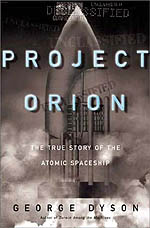|
| ||
May 3, 2002, 11:11AM Orion: a spaceship with a heck of a beltBy MARK CARREAUPROJECT ORION: WITH Project Orion: The True Story of the Atomic Spaceship, author George Dyson offers a fascinating new perspective on the earliest days of America's space program.
The prolonged Cold War generated many grandiose scientific and technical projects, among them the Star Wars missile defense system, the effort to land a man on the moon, spy satellites, nuclear submarines. Dyson reveals a lesser-known but all the more amazing scheme. He describes the largely clandestine attempt by a small team of World War II bomb designers to convert their weapons of mass destruction into a new propulsion source for a behemoth interplanetary spacecraft. Bankrolled by $10 million in federal funds, this team of about 50 experts plotted to develop a human spacecraft theoretically capable of establishing Mars settlements and embarking on long missions to the far reaches of the solar system. "Saturn by 1970," they proclaimed. However, the nearly seven-year effort drew to an anticlimactic end in 1965. Dyson, the son of the eminent physicist Freeman Dyson and one of the Orion project's top consultants, unravels the amazing saga in skillful fashion by weaving the still passionate recollections of aging participants with historical details gleaned from obscure government documents. After World War II, the architects of America's atomic bomb either regrouped to work on the more powerful hydrogen weapon, returned to their peacetime pursuits or looked for new endeavors. The Orion team was assembled in San Diego by former Manhattan Project physicist Frederic de Hoffman, who was at General Atomics, a division of defense contractor General Dynamics. Ostensibly formed to seek commercial markets for atomic power, General Atomics became a haven for some of the most gifted bomb designers, including Theodore "Ted" Taylor, who became Project Orion's inspired leader. With the federal government's Advanced Research Project Agency and the Air Force serving as overlords, Taylor's team formulated plans for 4,000- to 10,000-ton spacecraft propelled by the explosive forces of atomic and hydrogen bombs. The theorists envisioned their 25-story-tall spacecraft lifting off from Earth's surface and hurtling toward deep space at an incredible velocity. The idea was to stockpile thousands of atomic weapons aboard these spacecraft. As Orion ascended, the bombs would be jettisoned every quarter to half second, aimed and timed to explode just dozens of feet away. "It will work, and it will open the skies to us," Freeman Dyson predicted in 1958. "The problem of course is to convince oneself one can sit on top of a bomb and not be fried." The Orion team was convinced it could tame the explosive forces. These experts' confidence was based on protective features that included 100- to 200-foot-wide steel discs called pusher plates. Aft of the spacecraft, the pusher plates were suspended below large shock absorbers designed to convert the force of the blasts into a tremendous momentum for the big ships. The domed crew compartment was positioned safely above the pusher-plate and shock-absorber assemblies. Fleets of well-provisioned Orion spacecraft would be dispatched to Mars or the moons of Jupiter and Saturn or into Earth orbit. On board would be dozens of scientists and soldiers. Whole families might be dispatched on multigenerational voyages to the closest stars. Ultimately, Orion was orphaned by the Pentagon and died largely a theoretical exercise. Struggling to reach the moon with conventional rockets, NASA was not interested in a concept so radical. Fear of the radiation that would be unleashed during test flights was too much for even Orion's staunchest supporters. During most of Orion's brief life, the United States and the Soviet Union were engaged in almost unrestrained atomic experimentation, including frequent atmospheric tests of larger and larger weapons. But under growing global pressure, the two nuclear superpowers agreed to stop atmospheric testing under the terms of a 1963 test-ban treaty. The treaty dashed hopes for Orion. Even an 11th-hour bid to loft the planetary cruisers out of the atmosphere with conventional rockets before setting off the nuclear fireworks failed. Orion seems like an incredible pipe dream. But superpower fears and suspicions drove Cold War thinking. "It was a crazy era," Brian Dunne, Orion's chief scientist, informed the author. "All of our values were tweaked by the Cold War. It was a closed society, and all kinds of crazy ideas were able to grow." Earlier this year, the Bush administration directed NASA to re-examine the nation's space nuclear options. Initially, the agency hopes to restart production of the small plutonium generators that furnished the electrical power for the Pioneer, Voyager and Galileo spacecraft that gave us the first close-up images of Jupiter, Saturn and other bodies deep in the solar system. But new NASA Administrator Sean O'Keefe is also pressing the case for using the same fission reactors that have successfully powered the Navy's submarines and aircraft carriers for a half-century. Without the reactors, the United States cannot sustain its reach into deep space, he asserts. One can only speculate what it would take to rekindle interest in an Orion-style spacecraft. But if astronomers were to spot a huge asteroid barreling toward Earth, the once fanciful Orion, possibly fueled with bombs contributed by all the world's nuclear powers, might offer one of the few viable strategies for intercepting and destroying it. The fears that long ago grounded plans for the swift spacecraft would then pale in the face of a new global threat.
Mark Carreau covers NASA for the Chronicle.
|
| |||||||
|











